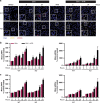SLFN11 informs on standard of care and novel treatments in a wide range of cancer models
- PMID: 33339894
- PMCID: PMC7921667
- DOI: 10.1038/s41416-020-01199-4
SLFN11 informs on standard of care and novel treatments in a wide range of cancer models
Abstract
Background: Schlafen 11 (SLFN11) has been linked with response to DNA-damaging agents (DDA) and PARP inhibitors. An in-depth understanding of several aspects of its role as a biomarker in cancer is missing, as is a comprehensive analysis of the clinical significance of SLFN11 as a predictive biomarker to DDA and/or DNA damage-response inhibitor (DDRi) therapies.
Methods: We used a multidisciplinary effort combining specific immunohistochemistry, pharmacology tests, anticancer combination therapies and mechanistic studies to assess SLFN11 as a potential biomarker for stratification of patients treated with several DDA and/or DDRi in the preclinical and clinical setting.
Results: SLFN11 protein associated with both preclinical and patient treatment response to DDA, but not to non-DDA or DDRi therapies, such as WEE1 inhibitor or olaparib in breast cancer. SLFN11-low/absent cancers were identified across different tumour types tested. Combinations of DDA with DDRi targeting the replication-stress response (ATR, CHK1 and WEE1) could re-sensitise SLFN11-absent/low cancer models to the DDA treatment and were effective in upper gastrointestinal and genitourinary malignancies.
Conclusion: SLFN11 informs on the standard of care chemotherapy based on DDA and the effect of selected combinations with ATR, WEE1 or CHK1 inhibitor in a wide range of cancer types and models.
Conflict of interest statement
J.A., G.J.N., L.T., A.L., M.J.O. and E.L. are full-time employees and shareholders of AstraZeneca. M.J.S., T.P., T.B., A.T.W. and A.J.P. were AstraZeneca employees. C.W. is a PostDoc Fellow, and T.P. and M.J.S. were PostDoc Fellows of the AstraZeneca PostDoc program. A patent has been filed to the DDA/WEE1 inhibitor results that can modulate SLFN11 associated chemoresistance presented in the paper.
Figures






Comment in
-
The role of Schlafen 11 (SLFN11) as a predictive biomarker for targeting the DNA damage response.Br J Cancer. 2021 Mar;124(5):857-859. doi: 10.1038/s41416-020-01202-y. Epub 2020 Dec 16. Br J Cancer. 2021. PMID: 33328609 Free PMC article.
References
-
- Stewart C, Tong P, Cardnell J, Sen T, Li L, Gay M, et al. Dynamic variations in epithelial-to-mesenchymal transition (EMT), ATM, and SLFN11 govern response to PARP inhibitors and cisplatin in small cell lung cancer. Oncotarget. 2017;8:28575–28587. doi: 10.18632/oncotarget.15338. - DOI - PMC - PubMed
Publication types
MeSH terms
Substances
Grants and funding
LinkOut - more resources
Full Text Sources
Other Literature Sources
Medical
Miscellaneous

